Open Source: A wonderful idea that leads to some very questionable results. I’m referring, of course, to the old Wikipedia entry for Star-Lord, which is not merely confusing but utterly useless and has in fact been known to cause dementia and heart palpitations in laboratory mice. The simple truth of the matter is that Star-Lord’s backstory is HIGHLY confusing, filled with golden intentions and tangled antecedents, and while there’s a lot going on, some of it is practically incomprehensible. Blame that on 70’s Marvel’s rotating Editors-In-Chief, or perhaps the need to fill hundreds of pages on relatively short notice. Either way, as a small-time-comics-historian-slash-big-mouth-know-it-all, I felt the burden to try to clear a few of these loose ends up, once and for all, if only to save the brain cells of the youth of America who might want to know where Richie Ryder’s snarky right-hand man came from…
It’s interesting to me that this is Major Spoilers post #2001, because we’re truly about to embark upon a Space Odyssey! When Steve Englehart created the Star-Lord in 1976, it was his intention to create an epic tale, a transformation of a normal, self-centered, brash, impatient and wholly unpleasant man into a cosmic savior of the universe, and filter that transformation through his interest in astrology, with each succeeding story giving Peter Quill texture and experience to turn him into something beyond human. The step-by-step journey would allow Steve to write about a new passion, and would leave Star-Lord a true force for good in the galaxy. And, of course, he only got as far as “unpleasant, introverted jerk” before leaving the title and the company behind. When new writers took over, the story of Pete Quill went someplace a bit different, but that’s only natural, given how it began… The year is 1962, and young Meredith Quill has given birth during a peculiar stellar event.
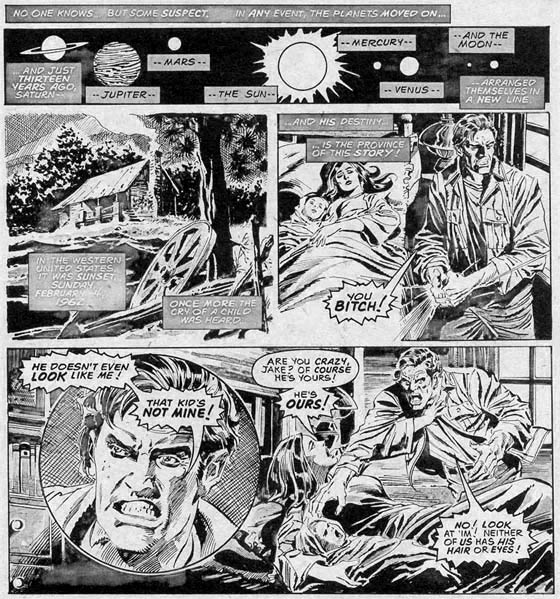
“And since we’uns wuz carved outta clay a week ago, they’s no way thet any o’ them features mighta come f’um our ancestors, neither, cuz we don’t believe in thet dang ol’ Everlution, neither!” Whattamaroon. Though infant Peter didn’t know it, the influence of the heavens in his life would be profound, but all Papa Jake knew was that Lizard-brain influence to kill that which is different. One of the most disturbing moments in Marvel Comics’ history plays out as the man we shall henceforth refer to as “Redneck McEvilDaddy” decides to deal with his wife’s “infidelity.”

And that, dear friends, is an example of what my friend Bruce would call ‘Cosmic Justice’ in it’s purest form. Those long moments of staring into the heavens would shape Peter Quill’s childhood, giving him a fascination with what might be out there. Meredith, for all her bad taste in men, raises the boy herself, and makes a wonderful parent. Peter watched the moon landing with awe, and was fascinated when he found a charred circle in a hidden grove, a local landmark which the locals claim is the site where the spacemen landed. This makes Peter Quill dream even more of the stars, and the people who he might find there, and one afternoon during his 12th year, his destiny arrives, in the form of a flying saucer.
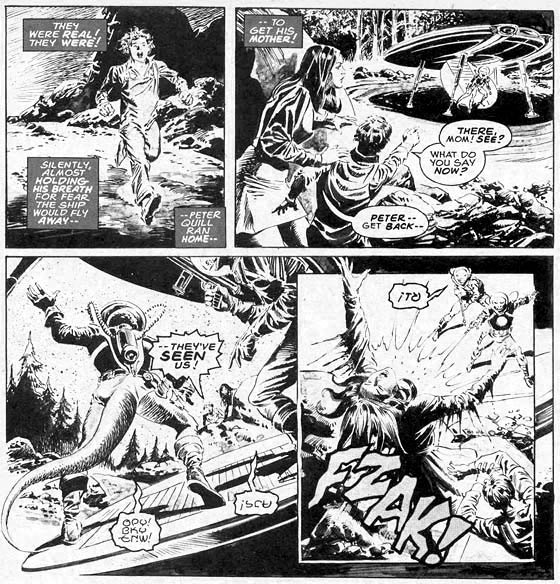
His beloved mother is killed, and predictably, the local yokels think the child’s story of aliens is just trauma. Though only eleven years old, Peter Quill is filled with an adult-size rage and a thirst for vengeance. “Men from outer space killed my mother… and no matter WHAT I have to do, I’ll find a way to make those spacemen pay! I SWEAR IT!” Raging like a loon, Peter is turned over to the custody of the state, but runs away a few years later. Years pass, and young Peter devotes his entire being to becoming an astronaut, to the exclusion of all else. He has no friends, no relationships, nothing but an apartment crammed full of star charts and astronomical equipment, and a true contempt for all things. When an accident occurs in the training facility, it’s Quill who has the reflexes to respond in time…

Harrelson (Not Woody, mind you) thanks him profusely, and even worries that Peter hurt himself, but Quill is just stunned at the lower-life forms. “Of COURSE I’m all right, no thanks to you! You could have saved yourself if you had a BRAIN instead of a muscle between your ears!” This diatribe turns what could have been a comradeship into a Cold War and pure hatred from Harrelson. Some months later, when the astronauts are chosen for the coveted Mars probe mission, Harrelson gets the nod over Peter, solely because Peter is such a jackass that no one wanted to spend sixteen months locked in a capsule with him. Smashing his charts, Peter falls into a bottle of whiskey, and when he comes out, he makes the decision to actively repair his reputation. He manages to snag a seat on a less-prestigious mission, and the zero gravity of space feels like home. He is stationed on an orbiting satellite, and for the first time since his birth, the heavens align, as Neptune, Uranus, Saturn, Mars, Venus and Mercury align during a lunar eclipse. Suddenly, the station receives a strange message from beyond…
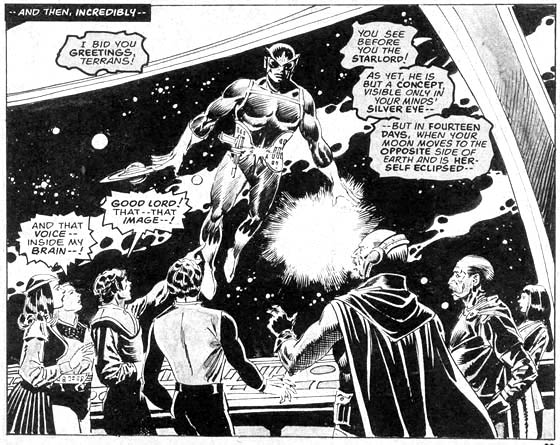
Earth Command immediately comes together to discuss the message, and decide to choose an emissary to the stars. When Peter Quill volunteers, he’s told that someone with more space experience should go, especially since they don’t believe what the image has told them. Peter rages out of control, screaming his frustrations and smashing the viewscreen, causing him to be promptly drummed out of service. His mortal enemy Harrelson is to be sent in his stead, but Peter breaks into the ceremony roaring his intent to become the Star-Lord and take his vengeance out on his mother’s killer. Peter pulls a gun and SHOOTS Harrelson (though with a stun-ray) and is quickly overcome. As the guards surround him, they prepare to shoot, and the frap-gun rays obliterate all trace of Peter. But he wasn’t disintegrated, he was teleported… teleported into the presence of someone who looks very Old-Testament-familiar.
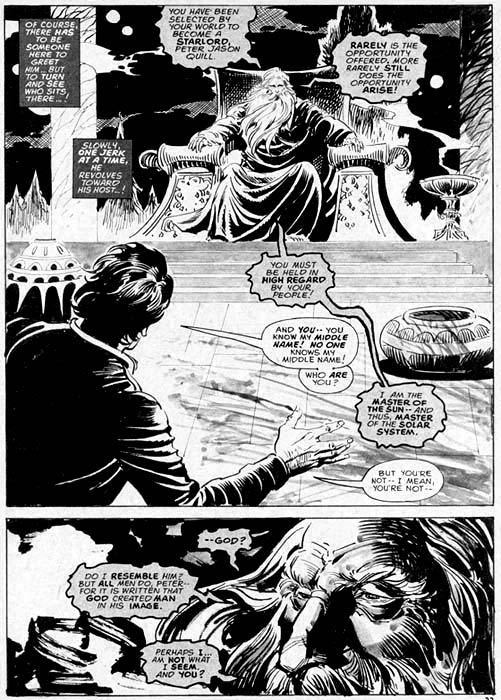
Peter admits that he, too, is not what he seems, and explains his long-ago oath to avenge his mother… Young George Lucas writes this all down, in case he wants to use it later, and the Master of the Sun transforms him into Star-Lord, giving him the power to fly, and a side-arm that fires any of the classical four elements (Earth, Air, Fire, & Water, another astrology reference) and is told that his only weakness is the weaknesses of Peter Quill’s own mind. The Master of The Sun teleports him out into space, where he sees a familiar ship, the very ship that landed in the bayou when he was a child. Peter follows, and makes the fateful decision to attack…

His bloodlust sated, Star-Lord flies into the cosmos, free of his human concerns for the first time. This “Earth house” adventure, according to Steve Englehart’s website, would be followed by adventures through the various planets of the heavens, telling a fast-paced adventure story on Mercury, a romance on Venus, a war-story on Mars, etc. Those never came to be, as Steve left the House of Ideas for greener pastures, and it was the following summer that the second Star-Lord tale finally appeared. This second tale (by the Uncanny X-Men team of Claremont and Byrne) begins on the planet Windholme, which for 300 years has stood relatively untouched as a sea-faring race of nomads. Now, the Empire has finally turned their attention to the planet, and now they intend to pillage Windholme for all it’s worth…

The boy (Kip, son of Gunnar Holm, and one of the few guys who can rock a toga, hot pants and corsair boots) is beaten down but the armored guards, and thrown in his cell. As with every space movie, he is able to slip into the air vents, and escape, but he meets another refugee in the tunnels, a young girl called Sandy. Any resemblance of Kip and Sandy to Luke Skywalker and Princess Leia is solely due to it being 1977… As the slaver ship leaves Windholme, they’re suddenly shocked by the appearance of the main character, in a melancholy and thoughtful state.
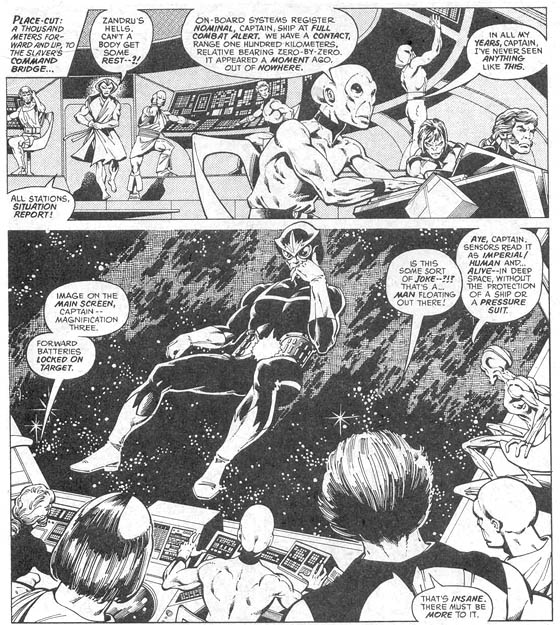
Suddenly, Star-Lord’s ship appears, and sweeps in for an attack, quickly and easily crippling the slaver ship. Peter Quill himself, feeling much more heroic, bursts into the ship, and begins punishing the Imperials for their hubris on Windholme. His attack frees the slaves, most of whom are afraid to do anything, but Kip quickly grabs a weapon and fights his way to the bridge. The hundreds of slaves overwhelm and rip apart the crew, beating them down with whatever they can find, bludgeons, hammers, even chunks of the bulkhead. When they’ve succeeded, Star-Lord tells them the bad news: their homes have been destroyed by the Imperial terraforming process, but they can all settle on Windholme. Kip leaps forth and challenges him in his hubris.
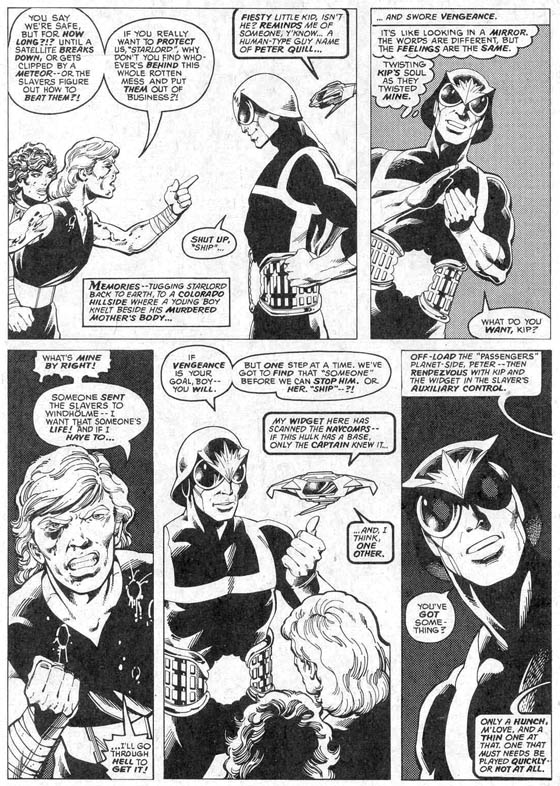
Suddenly, I suspect that there’s a bit of Space Ghost in Chris Claremont’s Star-Lord, as he agrees to take Kip and Sandy with him to find the Slaver’s base. Kip, it turns out is a “Windrunner” a psychic navigator whose inherited skills are what made his father the best fisherman on Windholme. He points out the planet, and Ship psychically transfers the information to Quill, and the set sail for Cinnabar. They find a planet divided into haves and have-nots, where the rich float above the planet in cities of gold (just like that old Star Trek episode.) Star-Lord is attacked, but finds that even his formidable weapons can’t destroy the self-repairing sentries. They’re led into a trap, and suddenly find themselves on the seas of Windholme, on Kip’s father’s ship. Kip realizes that he’s been here before, and Star-Lord leaps into action to fight an attacking giant Kraken…

The power of Star-Lord sees right through the illusion, and blasts the telepathic crystal that is creating their shared hallucination. The telepathic villain discovers the secret truth about Star-Lord, but Sandy quickly kills him, recognizing his tiny hidden blaster, aimed at Star-Lord’s heart. Kip and Sandy realize that they’re in luuuuuurve, and the threesome escapes the ship (thanks to an impromptu flood from the element gun) and races away. The entire floating palace explodes immediately after…
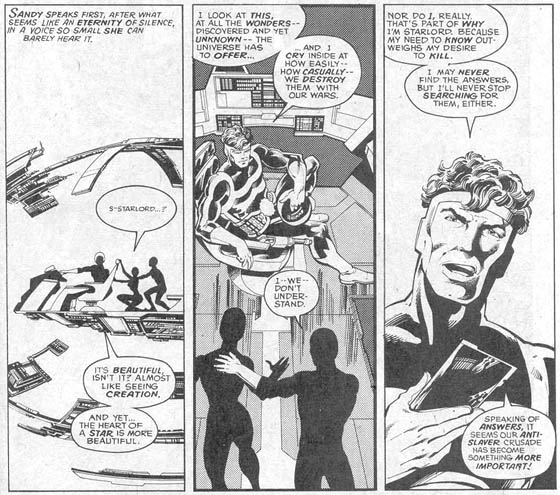
The Slavers have apparently been funneling their money into an attempt to overthrow the Emperor. Loading Kip and Sandy into a tiny shuttlecraft, Star-Lord flies off, having a very Claremont discussion with ‘Ship’ telling her that she’s his only friend, then breaks into the ship of Gareth, the Emperor’s uncle, and the mind behind the coup attempt. After freely the captured Kip and Sandy, Star-Lord quickly faces off with Gareth’s personal guard, a creature Peter knows. “That face… even though he was wearing a HELMET then, it’s HIM!” Peter Quill finds his hate rising, fighting against his base urges, even as he fights the thing that killed his mother. Running him through, Star-Lord turns and faces Gareth in combat, fighting with ancient rapiers. A superior fencer, Gareth knocks off Peter’s helmet, and is stunned to see the face beneath is familiar. Quill kicks his weapon away and threatens to kill the Prince…

That’s two murders in about ten minutes, a pretty prodigious change from the man who decided that killing is beneath the Star-Lord in issue #4. A big fan of Shakespeare, Gareth has poisoned his sword, and Star-Lord is taken into custody. Ship arrives, then Kip and Sandy arrives with the true Emperor…
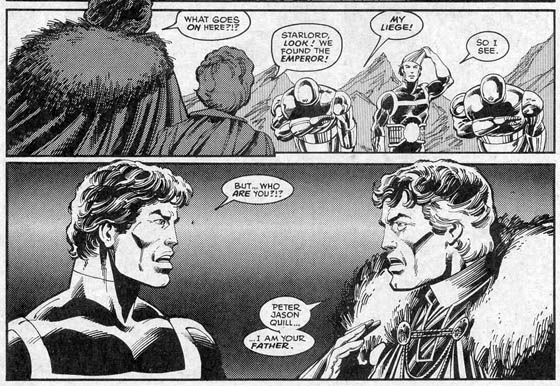
“Nooo! That’s IMPOSSIBLE!” “Trust your feelings, Star-Lord… you KNOW it to be true…” Keep in mind, this is 1977, a full five years before The Empire Strikes Back. Emperor Jason of Spartax explains that he hasn’t always had the stomach for affairs of state, and in his youth he spent years just exploring. When a desperate summons came from home, he pushed his ship so hard that he was forced to crash-land on a small blue planet, landing near a familiar looking native woman…
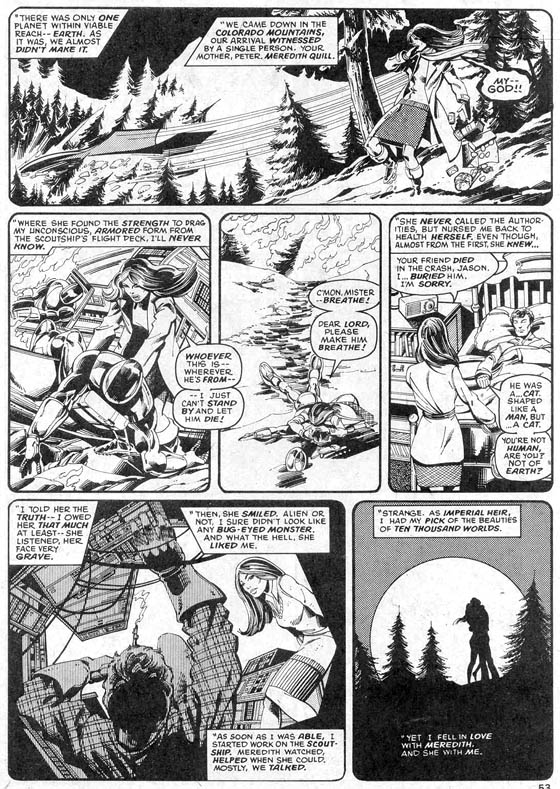
Jason repairs the ship, but refuses to take Meredith along with him for fear that the drive will fail and kill them both. He tells her that he’ll return, but then telepathically locks her memories of him to keep her from pining. Meredith follows her previous path, marrying her childhood sweetheart, Redneck McEvilDaddy (who, ironically, was right when he declared that the baby wasn’t his.) The death of Meredith was actually an attempt on PETER’s life by Gareth’s personal bodyguard, as Peter is next in line for the Galactic throne. Jason offers him a life with his long-lost father, but Peter tells him he has another calling, that of the Star-Lord, and returns to Ship, his only friend.

It’s a very Claremont ending, with the lone hero giving up everything that a normal person wants for his destiny. It’s also an interesting contrast from what Englehart wrote, with the end of issue #4 having a similar yet completely different feel, as the ultimate outsider finds himself where he belongs at last… That initial concept of outsider slowly working his way towards heroism and transcending his human frailties went away, subsumed into a different story (though still an interesting one) with echoes of Heinlein, of Star Wars, of space operas old and new. Neither take is inherently superior, but with a change in direction like that in between the first two issues, you can see how the Star-Lord didn’t really take off like the rocket Marvel might have wanted, and why the Wiki entry is such a cluster-schmozz. Based on the quality of the issues, and the fact that both Englehart and Claremont are masters of the comic form who are responsible for a huge number of the things we love about Marvel and DC, I have to rank the combined force of Marvel Preview #4 and #11 3.5 out of 5 stars.




9 Comments
Well, this article has been up for about half an hour, and somebody already linked it to Wikipedia. :)
My work here… is DONE!
Heh. Well done. You cleared up alot of the confusion that I had when I first read the Wiki entri.
Dude, that is a pretty awesome origin story. Being left, as an infant, staring at the stars… very cool. Thanks for writing this.
I loved that Claremont version of Star-Lord back when so thank you for the trip down memory nebula!
Is his origin British Marvel like Captain Britain? The art looks British and I wouldn’t think a US comic would have the word “Bitch” and a threat to take an axe to a baby.
Nope… It’s not British, it’s from Marvel’s black and white oversized line of magazines which were written for a more adult audience, even occasionally featuring nudity, sexual situations, and language. They’re actually quite cool, I recommend snapping them up if you ever see them.
on behalf of all the youths that come to this website including me i would like to thank you Matthew you self proclaimed small-time-comics-historian-slash-big-mouth-know-it-all for a review of a character i knew nothing about i fell less ingnorant know and can read the new Star-Lord comic
I read the Claremont-Byrne Star Lord before I discovered X-Men and I’ve always had a fondness for it. One great story. Thank you!
Golly – I’ve not laid eyes on these images for forty (of your Earth) years!
Star Wars Weekly (British 70’s rag) was my window into Starlord’s universe and it shook me then (such artwork! Ship!) and now.
Thank you!